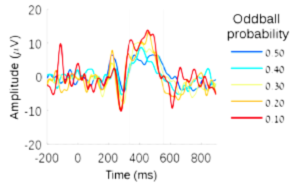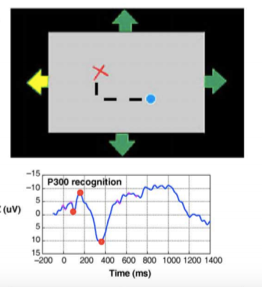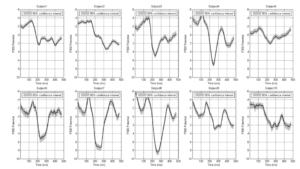The P300 Event Related Potential or ERP is an EEG feature commonly used in BCI applications. It has some advantages but also some significant practical challenges and shortcomings.
In the previous blog post we discussed some of the basic components that make up a BCI system, enabling the use of brain signals to control an external device which can be something as simple as a cursor on the computer screen or as complex as a prosthetic limb. Several BCI paradigms have proposed to elicit the appropriate brain signal to control the external device. BCIs are named according to the type of brain activity used for control. Among many different paradigms, the most popular ones include P300, steady state visual evoked potential, event related desynchronization (ERD) and slow cortical potential, which we will touch upon in a series of blog posts, starting with P300 in this post.
P300 paradigm
The P300 event-related potential component is usually generated during what is known as the oddball paradigm (1). Imagine listening to the following sequence : BEEP-BEEP-BEEP-BEEP-BEEP-BLOOP-BEEP-BEEP-. The sudden occurrence of BLOOP elicits a peak about 300 ms after the presentation of the stimulus.
In general, whenever a subject is presented with two classes of events such that one of them occurs rarely, we can obtain a P300 ERP component. Thus, when a person is asked to actively attend to the rare or infrequent stimuli, e.g. by counting their occurrences, the P300 wave is stronger than if the stimuli (visual or auditory) is only passively attended to. The lower is the probability with which the infrequent or rare event occurs, the stronger will be the P300 response (See figure 1). It has been reported that P300 is involved with the process of learning and things appear to be learned if, and only if, they are surprising [2]. However, we will not get into the neurophysiology of this, but rather focus on how we can use P300 in BCI applications.

Figure 1 : Relation between P300 amplitude and oddball probability (Taken from Wikipedia)
Since elici tation of a P300 component does not require specific training, but results from natural response of the neural system, the P300 component has been widely used for BCI systems. For instance, imagine a subject wanting to move the cursor (blue circle) to the left and upward towards the red cross as shown in Figure 2. In a P300 paradigm, this can be achieved by visually flashing all the four directions in a random manner and asking the subject to focus on the arrow in the desired direction. The target stimulus, left arrow in the case of the image shown, will elicit the P300, which can be recognized by the system and result in movement of the cursor in upward direction [3].
tation of a P300 component does not require specific training, but results from natural response of the neural system, the P300 component has been widely used for BCI systems. For instance, imagine a subject wanting to move the cursor (blue circle) to the left and upward towards the red cross as shown in Figure 2. In a P300 paradigm, this can be achieved by visually flashing all the four directions in a random manner and asking the subject to focus on the arrow in the desired direction. The target stimulus, left arrow in the case of the image shown, will elicit the P300, which can be recognized by the system and result in movement of the cursor in upward direction [3].
The most common and popular application in P300 BCI is the speller. Other applications have included robots, wheelchair control, games, virtual reality and brain painting.
Figure 2 (left from [3]): shows highlight of arrow eliciting cursory movement using ERP
Advantages of P300 BCI
Although P300 BCI can provide means for effective communication, they may be less effective in cases where the subject is not able to control his/her gaze, for example due to some disability. Non-visual modality might be preferred in such cases. Also, P300 BCI are mostly well suited for tasks that involve direct selection, such as choosing a character and may not be suitable for other complex tasks, in which case a hybrid BCI (i.e. combining P300 with other paradigms) may be preferred.
In general, event-related potentials (ERPs) are typically used in BCIs as they have the following advantages -1) ERPs are typically generated without any specific training, as a result of the brain’s natural response to stimuli 2) They occur at very short latencies, thus efficient and fast processing can be achieved. In particular, P300 based BCI are relatively fast, effective for most users and practically need no specific training.
Challenges and Shortcomings
However, there are several challenges and shortcomings as well when using ERPs in general, which also apply to the P300:
1) Typically many trials are needed since single-trial is dominated by background (i.e., stimuli irrelevant activity), resulting in low amplitudes. Averaging over many trials (typically several 100s) may be needed to increase the signal-to-noise ratio for reliable detection. The number of trials needed is an important characteristic as this determines the effective spelling rate, accuracy and, thus the practical usability of the system. For examples, as shown in [4], using 40 trials resulted in accuracy of 80% and spelling rate of 2.3 characters/minute, which is not ideal for practical use. Although, over the last decade, several efforts have been in the direction of achieving reliable, single-trial P300 classification.
2) ERP latencies vary across individuals (and also within the individual!). For example, the P300 responses generated by the same P300-speller may show different shapes/latencies among subjects (See figure 3), and also vary within the same subject. Studies have shown that P300 amplitude and latency vary among both normal and clinical populations. Such cross-subject variations can originate due to background EEG activity and have been linked to individual differences in cognitive capability. Due to the variability in P300 response across subjects, a classification model learned from EEG of one subject will not generalize to classify EEG of other subjects.

Figure 3 : P300 of ten healthy subjects calculated by averaging 820 EEG trials measured from healthy subjects, with grey area representing 95% CI. [7]
Due to diversity in experimental designs, subject characteristics as well as stimulation paradigms and tasks, the classification accuracy can greatly vary (see Table above). Thus, another key challenge is in the direction of optimizing these BCI systems to account for such individual differences.
References
- Donchin, Emanuel, and Michael GH Coles. “Is the P300 component a manifestation of context updating?.” Behavioral and brain sciences 11.3 (1988): 357-374.
- Donchin, Emanuel. “Surprise!… surprise?.” Psychophysiology 18.5 (1981): 493-513.
- Piccione, Francesco, et al. “P300-based brain computer interface: reliability and performance in healthy and paralysed participants.” Clinical neurophysiology 117.3 (2006): 531-537.
- Farwell, Lawrence Ashley, and Emanuel Donchin. “Talking off the top of your head: toward a mental prosthesis utilizing event-related brain potentials.” Electroencephalography and clinical Neurophysiology 70.6 (1988): 510-523.
- Guger, Christoph, et al. “How many people are able to control a P300-based brain–computer interface (BCI)?.” Neuroscience letters 462.1 (2009): 94-98.
- Townsend, George, et al. “A novel P300-based brain–computer interface stimulus presentation paradigm: moving beyond rows and columns.” Clinical neurophysiology 121.7 (2010): 1109-1120.
- Lu, Shijian, Cuntai Guan, and Haihong Zhang. “Unsupervised brain computer interface based on intersubject information and online adaptation.” IEEE Transactions on Neural Systems and Rehabilitation Engineering 17.2 (2009): 135-145.
- Mak, J. N., et al. “Optimizing the P300-based brain–computer interface: current status, limitations and future directions.” Journal of neural engineering 8.2 (2011): 025003.



















better results are likely to be obtained if the components of the P300 peaks are analysed instead of the response waveforms. These can be found by applying independent components analysis and extracting the impulse responses which constitute the peaks. See Jervis et al in the American Journal of Alzheimer’s disease and Other Dementias, 2020.